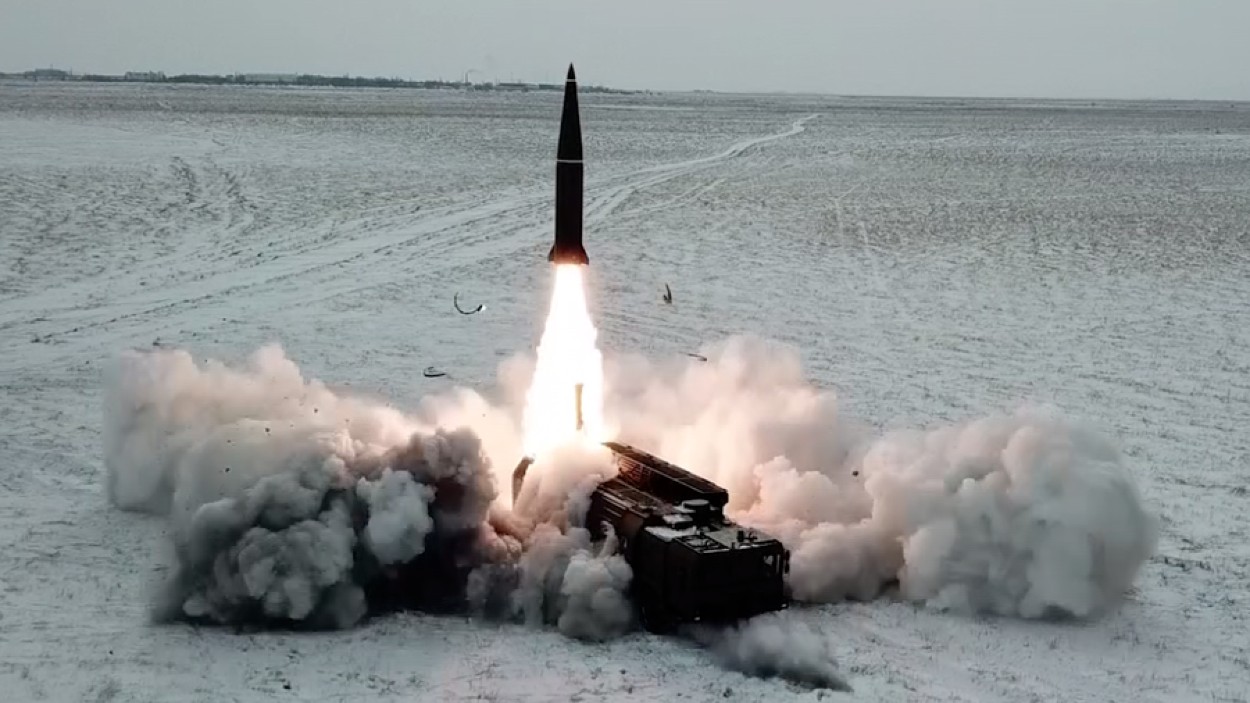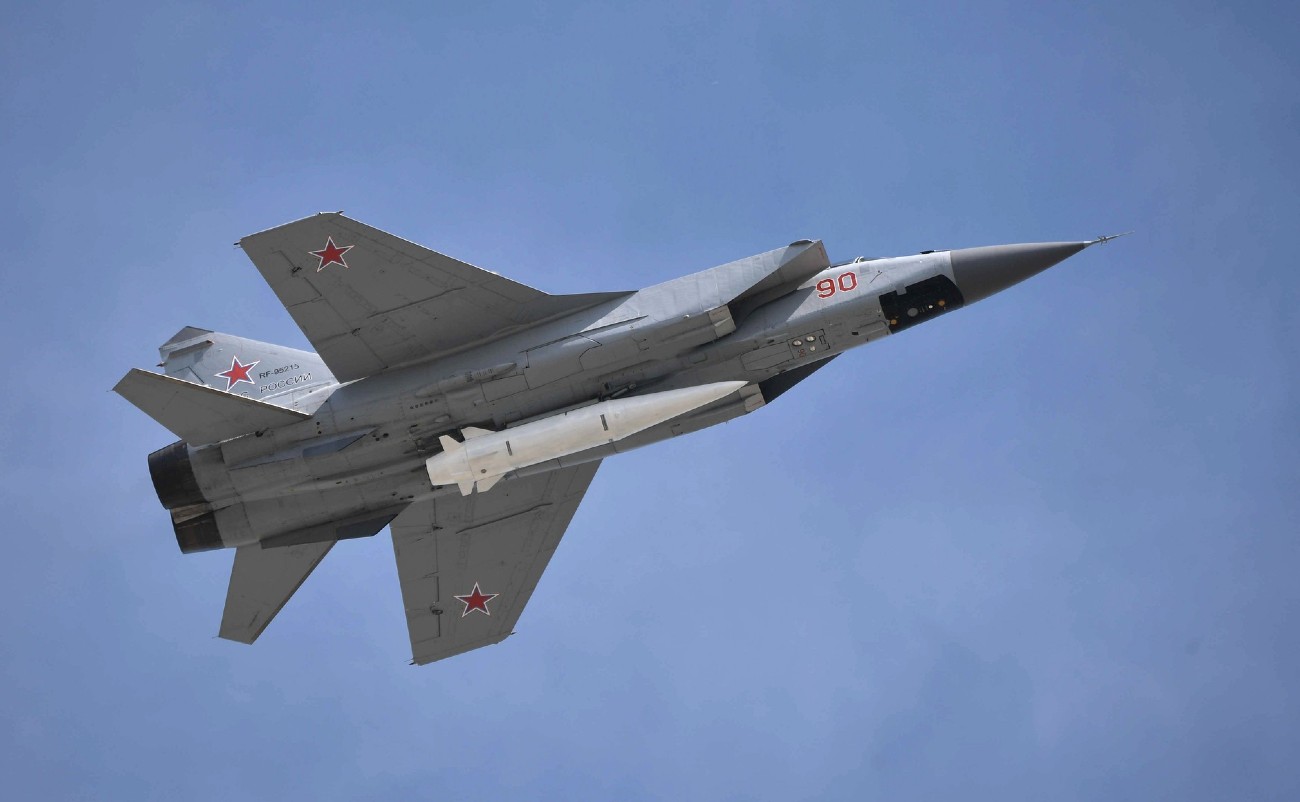Russia’s Iskander ballistic missile and the Kinzhal air-launched hypersonic cruise missile might get deadlier with increased range, powerful warheads, enhanced air-defense missile-beating maneuvering, and even ‘smarter’ enabling communication between themselves during coordinated mass salvo fires.
The missiles, along with the Kh-101 air-launched cruise missile (ALCM), the sea-launched Kalibr cruise missile, and the Geranium-2 (Geran-2) kamikaze drone, have been the mainstay of Russia’s long-range standoff fires into Ukrainian cities and battlefield targets.
They are targeted at civilian-military targets like “decision-making” centers, as the Russian Ministry of Defense (RuMoD) calls them in its publicity material; ammunition and ordnance “storage warehouses” in Ukrainian cities; “transport hubs” carrying war wares into Ukraine; and electricity “power distribution” systems.
On the frontline, they strike “command and control” centers, “troop concentrations,” “war material,” and “air defense placements” of Ukraine’s Soviet and Western-origin surface-to-air missile (SAM) platforms which includes IRIS-T, Patriot, NASAMS etc,
Improving Iskander & Kinzhal
Russian Defense Minister Sergei Shoigu recently suggested improving the “performance characteristics” of the missiles during a visit to the Mechanical Engineering Design Bureau in Kolomna.
“The Iskander and Kinzhal missile systems need to be modified taking into account the experience of their use in the Northern Military District,” Shoigu was quoted by Izvestia.
In the report, military expert Dmitry Kornev explained the possible changes and tweaks that Russian defense scientists might incorporate. Kornev said the changes pertain to the missiles’ “flight characteristics” and “capabilities to overcome missile defenses” while “expanding” the type of “carrier aircraft” to deploy these missiles.
For instance, the Kh-47M2 Kinzhal is currently fired by the ‘K’ and ‘I’ variants of the MiG-31 interceptor (MiG-31K, MiG-31I). Russia is known to operate two squadrons of the MiG-31K. The last suggestion has already been carried out. TASS reported on September 4 that the Su-34 fighter bomber “used the Kinzhal hypersonic missile in the course of the Special Military Operation (SMO).”
It was first used on March 18, 2022. The inherent flexibility might, however, come with a slightly reduced range and speed since it is released from a comparatively slower jet like the Su-34, unlike the missile’s original carrier, the MiG-31K.
The choice of the Iskander-M and the Kinzhal might also stem from the fact that the two missiles also surprisingly share some characteristics in their kinematic performance. The Kinzhal can be assessed to be an Iskander-M missile minus its first stage. This means the two-stage Iskander flies a lot like the Kinzhal after dropping its first-stage booster.
Both missiles do not follow a classic ‘ballistic’ (or ‘parabolic’) trajectory, which makes it difficult for air defense radars to ‘calculate’ or ‘predict’ their position based on their existing speed and altitude. The Iskander follows a semi-ballistic course, where it flies like a cruise missile and reaches speeds over Mach 4, making it difficult to intercept.
The Kinzhal aeroballistic hypersonic missile touches even higher speeds, and any detection can only happen at the terminal stage when the missile has locked onto the target. Combined with its stated ability to change directions mid-flight in the guidance phase, intercepting it becomes almost impossible.

Ukraine has claimed on a few occasions of having shot down the Kinzhal but has so far not provided any conclusive evidence for the same. Even Western military analysts and defense officials — who are unofficially present on the ground as advisors providing Ukraine tracking data from US satellites, surveillance aircraft on Russian jets and missiles — have not been quoted saying that a Kinzhal had been downed.
Kornev suggests that Russia, too, has significantly learned about Western electronic intelligence (ELINT) and SAM performance so that it can further enhance its technology. This is possibly before Ukraine is provided a new generation of air defense missile software updates and tracking radars.
Iskander-M Tactical Ballistic Missile
The “operational-tactical” 9K720 Iskander-M, which has a range of 150 to 500 km, was inducted in 2006, followed by a massive “re-equipment of all the missile brigades in 2010-2011”. All units received the Iskander-M by 2020.
The Iskander-M carries two types of missiles that are completely different in their appearance and capabilities: the ballistic 9M723 and the cruise 9M728. It can be assumed that Russia uses the latter when it undertakes periodic missile barrages on Ukrainian cities, in coordination with the Gerans and Kh-101.
The EurAsian Times had noted in a previous analysis how Ukraine’s rising shootdowns of Russian missiles and drones were exhausting its stockpile of Western SAMs. Kornev said improvements could be made to the missile’s “flight characteristics, changing combat equipment, new carriers and new capabilities to overcome missile defense.”
With both the US and Russia having exited the Intermediate-Range Nuclear Forces (INF) Treaty, the Iskanders’ range can be increased from the current cap of 500 km. “Taking into account the latest advances in mixed solid fuels, it is possible to install a new engine in the 9M723, which gives it a range of 1000 km, while maintaining the mass of the warhead at least 500 kg. It is likely that work in this direction is already underway,” Kornev said.
Kinzhal Aeroballistic Missile
The Kh-47M2 Kinzhal missiles can carry “several types of warheads.” Chief among them is the “penetrating high-explosive (that) is designed to destroy fortified and protected targets.” It can “break through concrete floors and hit targets under thick soil.
The Ukrainian target it struck on March 18, 2022, was a Soviet-era large underground warehouse in Delyatyn village in the Ivano-Frankivsk region called ‘Object-711’ or Ivano-Frankivsk, built in 1955.
The 2,000 km range missile can also carry a conventional high-explosive fragmentation warhead weighing 482 kg. It can be launched in “open areas” that are one to two hectares in size to destroy equipment and infrastructure. Another cluster bomb warhead can release 54 bomblets, which leave the warhead casing at an altitude of 900 to 1,400 meters and explode at a height of about 10 meters. “The affected area is hundreds of square meters.”
A “room for improvement” could be “a heavier warhead with increased power for non-nuclear use.” This warhead can be used for “both Iskander and Kinzhal.” It can weigh 800 kg “or even more”. However, a “new engine” can retain the Iskander-M’s 500 km range with “double” the “explosive power.” This would be a completely logical modernization, according to Kornev.

One “publicly announced development” of the Kinzhal is making it compatible to be fired from the Tu-22M3M and Tu-160M ”Long-Range Aviation aircraft.” “This would make it possible to deliver more massive strikes with hypersonic missiles launching at targets simultaneously and from different directions.”
The Kinzhal was “created on the basis and using technological solutions of the 9M723 Iskander-M.” Its 2,000 km range allows it to hit “any target on the European continent in a matter of minutes,” with a maximum flight speed clocked at Mach 10 (ten times the speed of sound).
These missiles can also use “decoys to distract the attention of air defense missiles,” a technology already in use. EurAsian Times had reported that the Kh-101 was being recorded in a video, dropping decoys from its body during a low-level flight.
‘Smart Missiles that Can Talk’
Kornev’s next speculation, however, about Russia possibly developing software for Iskanders and Kinzhals to communicate between themselves autonomously seems ambitious.
“Groups of Iskanders and Kinzhals can attack complex targets with a defense system in a flock. The current level of technology development allows missiles to be capable of such an attack, and no modern missile defense system can repel it.”
Such technology will also greatly simplify the launch sequences and reduce the strained and vexing target engagement procedures on the crew. “Today, this probably looks almost like a fantasy, but tomorrow it could become a reality,” Kornev added.
- The author can be reached at satamp@gmail.com
- Follow EurAsian Times on Google News




